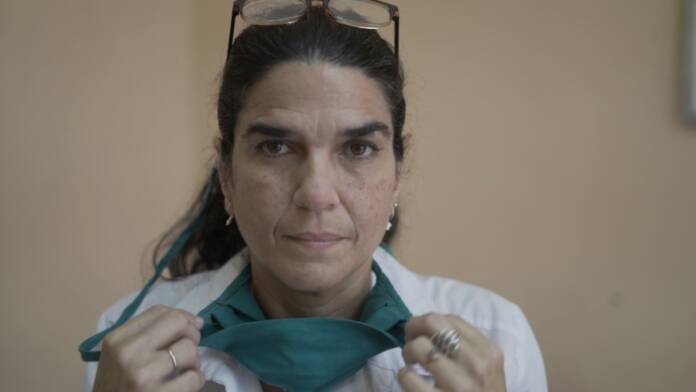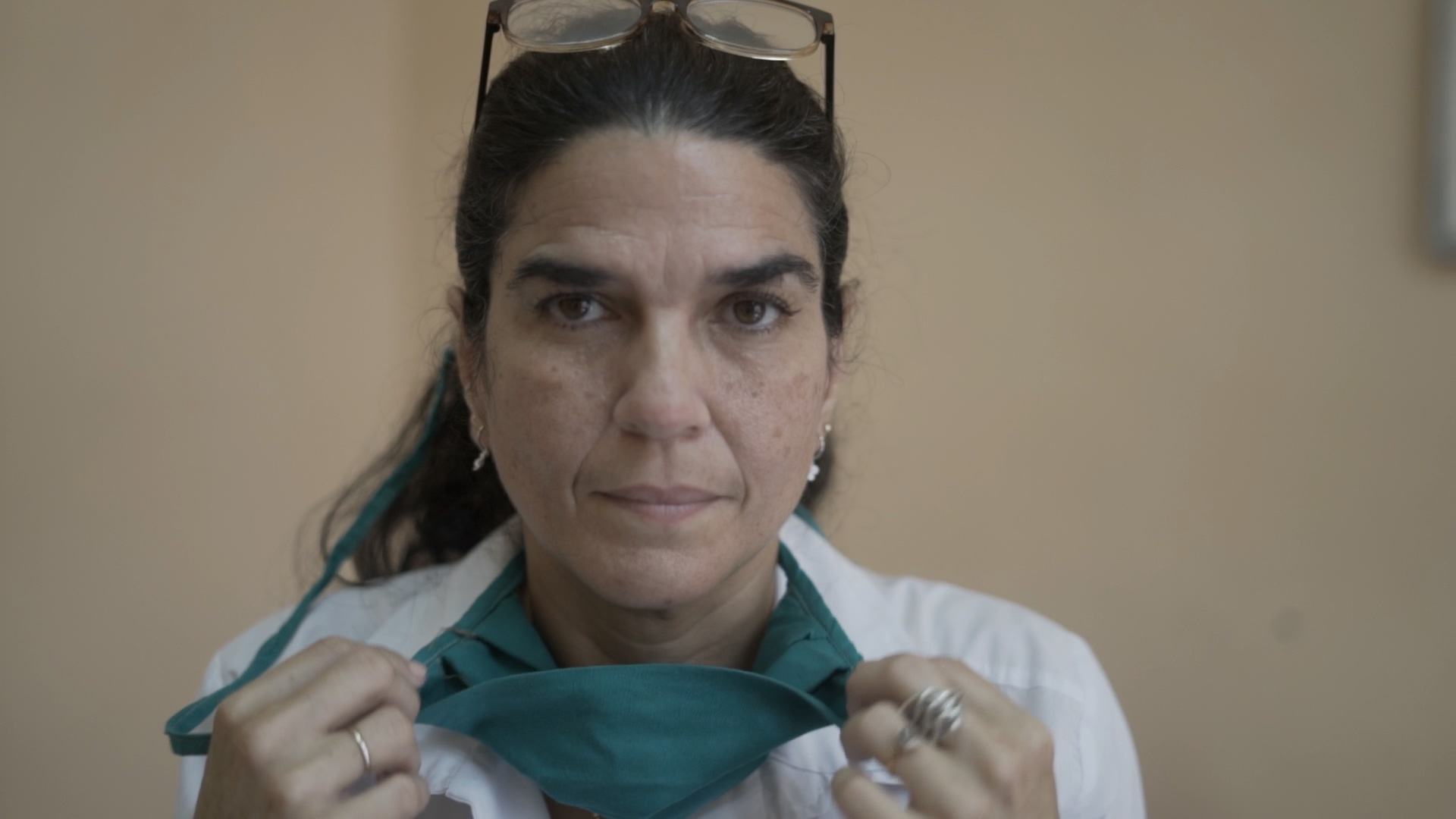
One morning along a street with cracked sidewalks and houses with fading paint, Dr. Liz Caballero and two medical students stopped at every door in that part of Havana’s Vedado district. During normal times, these neighborhood doctors practice preventative medicine. Now, they participate in a full-blown campaign against the COVID 19 pandemic.
Dr. Caballero knocked on a door and asked if anyone in the house had a fever or other COVID 19 symptoms. The resident replied everyone was fine.

“My son and wife are doctors and they disinfect before entering the house,” she said. “We all have surgical face masks. Even my boy has one.”
Community health workers are assisted by the Committees for the Defense of the Revolution, the country’s neighborhood watch organizations, and by the Women’s Federation. The government requires everyone to wear face masks outside. So many Cubans make their own.
Cuba faces shortages of testing equipment and some medications. People wait in long lines for chicken and toilet paper. But what the island lacks in material resources, it makes up for with a sophisticated public health system.
Public health authorities use classic anti-epidemic techniques to identify those infected, quarantine and treat them, and then trace all their contacts. See this short video from the Havana-based Belly of the Beast:
So far, government efforts have severely restricted the pandemic’s spread since it was first discovered among foreign tourists on March 11. As of May 22, out of a population of 11 million, Cuba had 1,916 COVID cases and only 81 deaths. The Cuban infection rate is .71 people per 100,000 inhabitants. The US rate is 29, about 40 times higher.
Victor Wallis, a political science professor at Berklee College of Music in Boston, attributed Cuba’s success to its socialist medical system.
Help us save local journalism!
Every tax-deductible donation helps us grow to cover the issues that mean the most to our community. Become a 48 Hills Hero and support the only daily progressive news source in the Bay Area.
“Cuba’s enormous investment in the health sector rather than the military is a new kind of priority,” he told me. “It focuses on human well being.”
Hugs and kisses
Cuba initiated a massive social distancing campaign, but Dr. Caballero admitted that enforcement can be hard in a Latin culture used to hugs and kisses on each cheek when greeting friends.
“Sometimes it is difficult to stop shaking hands,” she said. “But right now Cubans have internalized that the most important thing is social distancing.”
Here’s Dr. Caballero in a Belly of the Beast video:
Unlike the US, said Dr. Caballero, all medical care is free in Cuba, including dentistry, eye care and mental health services.
In Cuba, “people go to the doctor as soon as possible,” she said. “Sometimes in other countries they don’t go early because they don’t have health insurance; they don’t have money to pay.”
Cuba’s socialist medical system is different from anything politicians propose in the US. Even with the most progressive plans in the US, such as Bernie Sanders’ Medicare for All, the government would act as an insurance company to pay private doctors and hospitals.
In Cuba, the state runs the entire medical system from medical schools, to neighborhood doctors, to local clinics and hospitals.
After the 1959 Cuban revolution, Afro Cubans and people from working-class backgrounds were able to attend medical schools for the first time.
Starting with their first med school class, doctors are educated to serve the people, not seek fame and wealth. Education is completely free, and upon graduation, doctors must practice for three years in underserved communities and rural areas.
Cuba has among the world’s highest doctor/patient ratios. And Cubans have a higher life expectancy than in the US.
Today, Cuba has sent 30,000 doctors to treat people mostly in poor countries. Today, 2,000 doctors and nurses are fighting COVID 19 in 23 countries from Mexicoto Italy.
See what these doctors and nurses say about US government criticism of their work in this short Belly of the Beast video:
Starting in the 1970s, Cuba built from scratch a sophisticated biotechnology and pharmaceutical industry. Cuba has developed a number of internationally recognized pharmaceuticals.
Cuban scientists are currently conducting joint research into a lung cancer drug with the Roswell Cancer Center in Buffalo. Doctors in Cuba and China are using a Cuban interferon drug to treat COVID 19.
Serious problems
Cuba’s health care system has plenty of problems, however. Isis Allen, a 60-year-old journalist, stood in line outside a pharmacy in her Havana neighborhood. Her mother needs medicine for circulatory problems. Sometimes the pharmacy has the drugs, sometimes not.
“You can spend a day waiting in line at a pharmacy,” she said.
Her mother’s medicine must be imported from overseas. Even when Cuba makes the drugs in Havana, the health ministry has a hard time getting the raw materials.
Allen attributed shortages to the US trade embargo, known in Cuba as the blockade. She called the unilateral blockade “an embarrassment for the United States, a powerful country that is making this island, with such a hard-working and dedicated people, suffer so much.”
Food and medicine are supposed to be exempt from trade restrictions under the official terms of the embargo, which the US first imposed on Cuba in 1962. However, many companies–even those outside the US–fear prosecution in US courts and won’t trade with Cuba.
Swiss medical equipment corporations refused to sell Cuba ventilators in late April. A few weeks earlier, China tried to send Cuba surgical masks, gloves, ventilators and other medical supplies. But Avianca, the Colombian-based airline originally contracted to make the delivery, cancelled the flight, fearing US sanctions.
In another case the Swiss NGO MediCuba found that its bank wouldn’t transfer money to pay for shipping medicine to Cuba. The bank eventually agreed to the funds transfer. But in another incident, the bank of a pharmaceutical supplier refused MediCuba’s payments because the medicine would be shipped to Cuba.
Since it inception the US embargo has cost the island almost a trillion dollars in economic damage, according to José Ramón Cabañas, Cuba’s ambassador to the US. But it has failed politically. “Some people think they finally can defeat the Cuban Revolution. It won’t happen.”
The US blockade isn’t the only source of Cuba’s problems, however. Cuba gets most of its hard currency from tourism and remittances from citizens living abroad. The Cuban government closed the country to tourism in March and has not indicated when it might resume. So Cuba lacks hard currency to purchase food, petroleum and many other products.
For over a decade, the government has promoted economic reforms. The state continues to control major industries, while encouraging the growth of small, private businesses. Even before the current crisis, however, Cuba saw a growing currency black market and hoarding of scarce consumer products.
As I wrote after a January trip to Cuba, Cuban President Miguel Diaz-Canel had planned to raise state worker salaries and encourage provincial self sufficiency in food production. The growing world recession has made economic reforms all the more difficult.
To hug again
Despite these serious problems, the Cuban government has organized an impressive anti-pandemic campaign. The island’s heath care system is built on solidarity not profit, according to Professor Wallis.
“Cuban policies correspond to ancient medical precepts but have been ignored by US capitalism,” he said. “Treat people because they’re human beings in need. It’s their national policy.”
On a neighborhood level Dr. Caballero is optimistic about beating the pandemic. Cubans will return to normal lives, she said.
“When all this passes, we will hug again,” she said. “We will return to what we have always done.”
Reese Erlich has reported from Cuba since 1968 and is author of the book Dateline Havana: The Real Story of U.S. Policy and the Future of Cuba. Research for this article came from the Havana-based media outlet Belly of the Beast.

